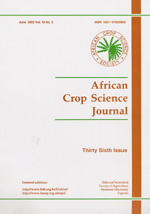
|
African Crop Science Journal
African Crop Science Society
ISSN: 1021-9730
EISSN: 1021-9730
Vol. 6, No. 3, 1998, pp. 249-258
|
 Bioline Code: cs98027
Bioline Code: cs98027
Full paper language: English
Document type: Research Article
Document available free of charge
|
|
|
African Crop Science Journal, Vol. 6, No. 3, 1998, pp. 249-258
| en |
Ontogenetic characteristics and inheritance of resistance to leaf anthracnose in sorghum
Tenkouano, A.; Miller, F.R.; Fredericksen, R.A. & Nicholson, R.L.
Abstract
The objectives of this study were to understand the effects of
ontogeny on the expression and inheritance of resistance of sorghum
(Sorghum bicolor [L.] Moench) to Colletotrichum graminicola
(Ces.)Wils., the causal agent of anthracnose. Two resistant cultivars
(SC326-6 and SC599-11E) and two susceptible cultivars (BTx623
and B35-6) were inoculated in the greenhouse at different growth
stages with three isolates of C. graminicola. The response of
SC326-6 was hypersensitive while the reaction of SC599-11E
was of a slow lesion delimitation type. Susceptible cultivars failed to
restrict lesion growth, particularly in older plants. All cultivars
produced phytoalexins in response to attempted infection, but synthesis of
these antimicrobial compounds started earlier and proceeded faster in
resistant cultivars. Field resistance to C. graminicola was
expressed in both juvenile and adult plants of SC326-6 and its
progeny. In contrast, reversal of resistance was observed in
SC599-11E and its progeny as plant aged. The frequency distribution
of disease severity indices was bimodal and fitted a 3:1 segregation,
suggesting that resistance was controlled by dominance at a single
multiallelic locus. The symbol cgl was proposed to designate the resistance
locus.
Keywords
Colletotrichum graminicola, host plant resistance, ontogenetic interaction, phytoalexins, Sorghum bicolor
|
| |
| fr |
Tenkouano, A.; Miller, F.R.; Fredericksen, R.A. & Nicholson, R.L.
Résumé
Les objectifs de cette étude étaient de comprendre les
effets de l'ontogénie sur l'expression et la transmission
génétique de la résistance du sorgho (Sorghum
bicolor [L.] Moench) au Colletotrichum graminicola (Ces.)Wils.,
l'agent responsable de l'anthracnose. Deux cultivars résistants
(SC326-6 and SC599-11E) et deux cultivars sensibles (BTx623
and B35-6) ont été inoculés en serre à
différents stades de croissance avec trois isolats de C.
graminicola. La réaction de SC326-6 a été
hypersensitive alors que SC599-11E a plutt freiné le
développement des lésions. Les cultivars sensibles n'ont pu
arréte la progression des lésions, notamment chez les plantes
agées. Tous les cultivars ont secrété des
phytoalexines en réponse à l'attaque, mais la synthèse
de ces composés antimicrobiens a démarré plus tt
et a progressé plus rapidement chez les cultivars résistants.
Au champ, la résistance à C. graminicola s'est
exprimée autant chez les plantes juveniles qu'adultes du cultivar
SC326-6 et de sa descendance. Par contre, on a observé un
renversement de la résistance avec l'age chez le cultivar
SC599-11E et sa descendance. La distribution de fréquence des
indices de sévérité de la maladie était
bimodale avec un ratio de 3:1, ce qui suggère que la
résistance est sous contrle d'un locus multiallélique
unique. Le symble cgl est proposé pour désigner ce
locus.
Mots Clés
Colletotrichum graminicola, résistance variétale, interaction ontogénétique, phytoalexines, Sorghum bicolor
|
| |
© Copyright 1998 - African Crop Science Society
|
|
